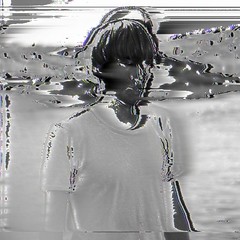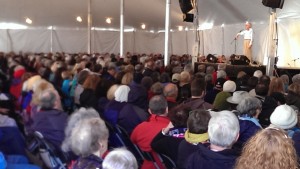Blog
The future of storytelling? Dispatches from NY and TN

Artist Neil Harbisson presented at FoST
Narrative Arts managing director Paul VanDeCarr attended two very different storytelling events back-to-back earlier this month.
A mannequin dressed in brightly colored clothing was wheeled out on to the stage of a theater on Staten Island. The house lights were dimmed, and a man’s face was projected onto the mannequin’s blank head. The face began to speak of cybernetics, of using technologies to extend the realm of human perception. The face was that of the Cyborg Foundation’s Neil Harbisson, who used art and technology as a corrective to his own colorblindness.
And so began this year’s Future of Storytelling (FoST) Summit, a gathering of “technology, media, and communications visionaries” shaping the way stories are told.
FoST founder Charlie Melcher addressed the crowd of some 550 people, saying that storytelling, or at least media, has become “disembodied,” and that our natural state is to be “participants” and “co-creators.” He forecasted an era of “sensual media,” or, in one of the most memorable lines of the gathering, “media that brings us back to our senses.”
Over the next two days of the Summit, we participants heard from speakers as wide-ranging as architect Bjarke Ingels (creating worlds in buildings) Netflix exec Todd Yellin (using data to predict what stories viewers will like) and General Electric’s Beth Comstock (telling stories to connect to customers). (Watch short videos about Summit speakers.) We visited the “Story Arcade,” where, through installations and iPads and other means, we went into the minds of straphangers in “Subway Stories,” touched tactile picture books for visually impaired children, or were immersed in the sights and sounds of Syria. We went on a “Story Crawl” to various interactive design agencies, and regrouped for closing performances, including a sing-a-long choral rendition of the Beatles’ “Tomorrow Never Knows.”
There was lots of tweeting, phone-checking, photographing.
Imagine the contrast, then, the very next day at the National Storytelling Festival, in small-town Jonesborough, Tennessee.
Scarcely a phone or iPad was to be seen during the performances, as thousands of people converged on the quaint historic center of town for a weekend of traditional storytelling. That is, people standing up in front of crowds to tell stories using no greater technology than a microphone and PA system.

Storyteller Donald Davis at TN festival
In the various large tents set up for the event, we heard from the likes of Donald Davis, whose homespun stories of his Appalachian childhood—squaring off against a schoolteacher, or trying to wiggle out of haircuts—left people laughing. And Bil Lepp mined his own youth and his imagination to tell tall tales that, no wonder, have made him a five-time winner of the West Virginia Liars Contest. In addition to personal stories, there were also plenty of folk tales, such as the African stories told by The Healing Force.
On Saturday night of the festival, there were ghost stories outdoors. The tellers told their stories from a gazebo, and perhaps a thousand people gathered on the grass around them under the stars. The air was cold and fresh, the grass was soft, the wind rustled the leaves in the trees. Torches planted along the edge of a whispering brook illuminated the area, and cast shadows to suit the mood.
Sitting there, I thought back to Charlie Melcher’s comments a few days earlier, about “media that bring us back to our senses.” Ironically, as an illustration of that idea, Melcher had spoken of an immersive theater piece from Punchdrunk—not a traditional play, more like an installation in which audience members interact with performers, sometimes one on one. In other words, no media involved, and no technology other than lights or a sound system. What seemed to enliven him most was the person interaction.
Technology can assist in these interactions, and can extend our senses and put us in contact with people far away. I was enriched by some of what I saw and heard at the FoST Summit. But I also had to wonder if the future of storytelling wasn’t only in a projection of light on a screen, but also in a park in small-town Tennessee. Or anywhere else that people come together to tell stories, face to face.
